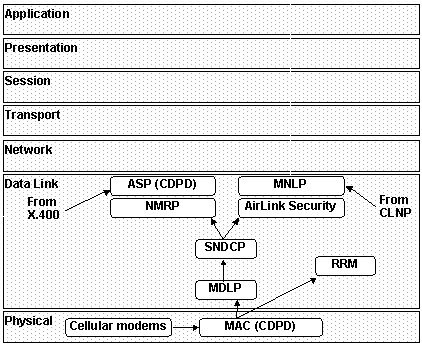 |
| ||||||||
 |
 |
 |
 |
 |
|
The basic structuring of the Cellular Digital Packet Data (CDPD) Network is along the lines of the 7-layer OSI model. Each layer within CDPD may be further partitioned into a similar sequence of sub-layers. Each layer or sub-layer in the CDPD network communications architecture is defined with:
The CDPD network specifications define a number of subprofiles as building blocks that may be selected and combined to define a particular CDPD network element. Subprofiles define the specific multi-layer protocol requirements for a CDPD network element or a CDPD network service. Three major classes of subprofiles are defined:
The following diagram illustrates the CDPD protocols in relation to the OSI model: CDPD System Specification release 1.1, part 403 The Mobile Data Link Protocol (MDLP) is a protocol that operates within the data link layer of the OSI model to provide logical link control services between Mobile End Systems (M-ESs) and Mobile Data Intermediate Systems (MD-ISs). MDLP utilizes the services of the CDPD MAC layer to provide access to the physical channel and transparent transfer of link-layer frames between data link layer entities. The purpose of MDLP is to convey information between network layer entities across the CDPD Airlink interface. It supports multiple M-ESs sharing access to a single channel stream. The channel stream topology is that of a point-to-multipoint subnetwork. In such a subnetwork, direct communication is possible only between the user side and the network side of the channel stream. Direct communication between two M-ESs on the same channel stream is not possible. The frame format of MDLP is as shown in the following illustration:
MDLP frame structure Address
Address field structure C/R TEI Control Information
CDPD System Spoecification release 1.1, part 404 The Subnetwork Dependent Convergence Protocol (SNDCP) provides a number of services to the network layer:
The SN-Data PDU is conveyed over the
acknowledged data link service in the DL-Userdata field of a DL-Data
primitive. The format of the SN-Data PDU is as shown in the
following illustration:
SN-Data PDU structure The SN-Unitdata PDU is conveyed over the
unacknowledged data link service in the DL-Userdata field of a
DL-Unitdata primitive. The format of the SN-Unitdata PDU is shown in
the following illustration:
SN-Unitdata PDU structure M K Comp
type NLPI Sequence
ID Segment
number Data
segment
| |||||||||||||||||||||||||||||||||||||||||||||||||||||||||||||||||||||||||||||||||||||||||||

